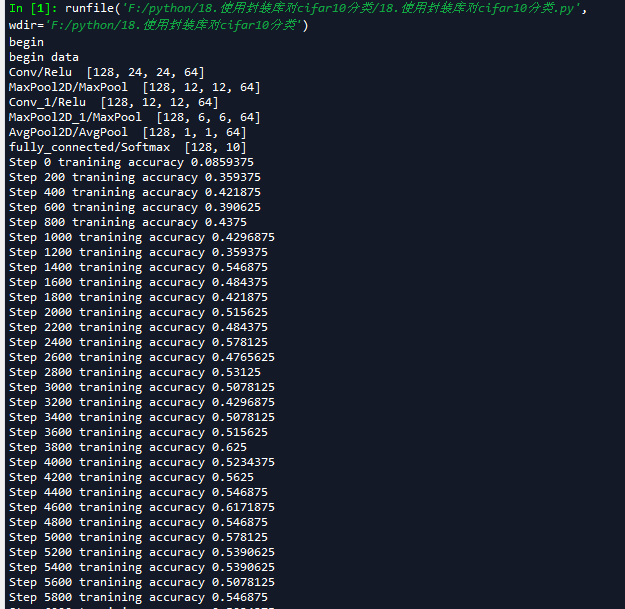第十六節,使用函式封裝庫tf.contrib.layers
阿新 • • 發佈:2018-12-14
這一節,介紹TensorFlow中的一個封裝好的高階庫,裡面有前面講過的很多函式的高階封裝,使用這個高階庫來開發程式將會提高效率。
我們改寫第十三節的程式,卷積函式我們使用tf.contrib.layers.conv2d(),池化函式使用tf.contrib.layers.max_pool2d()和tf.contrib.layers.avg_pool2d(),全連線函式使用tf.contrib.layers.fully_connected()。
一 tf.contrib.layers中的具體函式介紹
1.tf.contrib.layers.conv2d()函式的定義如下:
def convolution(inputs,
num_outputs,
kernel_size,
stride=1,
padding='SAME',
data_format=None,
rate=1,
activation_fn=nn.relu,
normalizer_fn=None,
normalizer_params=None,
weights_initializer=initializers.xavier_initializer(),
weights_regularizer=None,
biases_initializer=init_ops.zeros_initializer(),
biases_regularizer=None,
reuse=None,
variables_collections=None,
outputs_collections=None,
trainable=True,
scope=None):常用的引數說明如下:
- inputs:形狀為[batch_size, height, width, channels]的輸入。
- num_outputs:代表輸出幾個channel。這裡不需要再指定輸入的channel了,因為函式會自動根據inpus的shpe去判斷。
- kernel_size:卷積核大小,不需要帶上batch和channel,只需要輸入尺寸即可。[5,5]就代表5x5的卷積核,如果長和寬都一樣,也可以只寫一個數5.
- stride:步長,預設是長寬都相等的步長。卷積時,一般都用1,所以預設值也是1.如果長和寬都不相等,也可以用一個數組[1,2]。
- padding:填充方式,'SAME'或者'VALID'。
- activation_fn:啟用函式。預設是ReLU。也可以設定為None
- weights_initializer:權重的初始化,預設為initializers.xavier_initializer()函式。
- weights_regularizer:權重正則化項,可以加入正則函式。biases_initializer:偏置的初始化,預設為init_ops.zeros_initializer()函式。
- biases_regularizer:偏置正則化項,可以加入正則函式。
- trainable:是否可訓練,如作為訓練節點,必須設定為True,預設即可。如果我們是微調網路,有時候需要凍結某一層的引數,則設定為False。
2.tf.contrib.layers.max_pool2d()函式的定義如下:
def max_pool2d(inputs,
kernel_size,
stride=2,
padding='VALID',
data_format=DATA_FORMAT_NHWC,
outputs_collections=None,
scope=None):
引數說明如下:
- inputs: A 4-D tensor of shape `[batch_size, height, width, channels]` if`data_format` is `NHWC`, and `[batch_size, channels, height, width]` if `data_format` is `NCHW`.
- kernel_size: A list of length 2: [kernel_height, kernel_width] of the pooling kernel over which the op is computed. Can be an int if both values are the same.
- stride: A list of length 2: [stride_height, stride_width].Can be an int if both strides are the same. Note that presently both strides must have the same value.
- padding: The padding method, either 'VALID' or 'SAME'.
- data_format: A string. `NHWC` (default) and `NCHW` are supported.
- outputs_collections: The collections to which the outputs are added.
- scope: Optional scope for name_scope.
3.tf.contrib.layers.avg_pool2d()函式定義
def avg_pool2d(inputs,
kernel_size,
stride=2,
padding='VALID',
data_format=DATA_FORMAT_NHWC,
outputs_collections=None,
scope=None):
引數說明如下:
- inputs: A 4-D tensor of shape `[batch_size, height, width, channels]` if`data_format` is `NHWC`, and `[batch_size, channels, height, width]` if `data_format` is `NCHW`.
- kernel_size: A list of length 2: [kernel_height, kernel_width] of the pooling kernel over which the op is computed. Can be an int if both values are the same.
- stride: A list of length 2: [stride_height, stride_width].Can be an int if both strides are the same. Note that presently both strides must have the same value.
- padding: The padding method, either 'VALID' or 'SAME'.
- data_format: A string. `NHWC` (default) and `NCHW` are supported.
- outputs_collections: The collections to which the outputs are added.
- scope: Optional scope for name_scope.
4.tf.contrib.layers.fully_connected()函式的定義如下:
def fully_connected(inputs,
num_outputs,
activation_fn=nn.relu,
normalizer_fn=None,
normalizer_params=None,
weights_initializer=initializers.xavier_initializer(),
weights_regularizer=None,
biases_initializer=init_ops.zeros_initializer(),
biases_regularizer=None,
reuse=None,
variables_collections=None,
outputs_collections=None,
trainable=True,
scope=None):
引數說明如下:
- inputs: A tensor of at least rank 2 and static value for the last dimension; i.e. `[batch_size, depth]`, `[None, None, None, channels]`.
- num_outputs: Integer or long, the number of output units in the layer.
- activation_fn: Activation function. The default value is a ReLU function.Explicitly set it to None to skip it and maintain a linear activation.
- normalizer_fn: Normalization function to use instead of `biases`. If `normalizer_fn` is provided then `biases_initializer` and
- `biases_regularizer` are ignored and `biases` are not created nor added.default set to None for no normalizer function
- normalizer_params: Normalization function parameters.
- weights_initializer: An initializer for the weights.
- weights_regularizer: Optional regularizer for the weights.
- biases_initializer: An initializer for the biases. If None skip biases.
- biases_regularizer: Optional regularizer for the biases.
- reuse: Whether or not the layer and its variables should be reused. To be able to reuse the layer scope must be given.
- variables_collections: Optional list of collections for all the variables or a dictionary containing a different list of collections per variable.
- outputs_collections: Collection to add the outputs.
- trainable: If `True` also add variables to the graph collection `GraphKeys.TRAINABLE_VARIABLES` (see tf.Variable).如果我們是微調網路,有時候需要凍結某一層的引數,則設定為False。
- scope: Optional scope for variable_scope.
二 改寫cifar10分類
程式碼如下:
# -*- coding: utf-8 -*-
"""
Created on Thu May 3 12:29:16 2018
@author: zy
"""
'''
建立一個帶有全連線層的卷積神經網路 並對CIFAR-10資料集進行分類
1.使用2個卷積層的同卷積操作,濾波器大小為5x5,每個卷積層後面都會跟一個步長為2x2的池化層,濾波器大小為2x2
2.對輸出的64個feature map進行全域性平均池化,得到64個特徵
3.加入一個全連線層,使用softmax啟用函式,得到分類
'''
import cifar10_input
import tensorflow as tf
import numpy as np
def print_op_shape(t):
'''
輸出一個操作op節點的形狀
'''
print(t.op.name,'',t.get_shape().as_list())
'''
一 引入資料集
'''
batch_size = 128
learning_rate = 1e-4
training_step = 15000
display_step = 200
#資料集目錄
data_dir = './cifar10_data/cifar-10-batches-bin'
print('begin')
#獲取訓練集資料
images_train,labels_train = cifar10_input.inputs(eval_data=False,data_dir = data_dir,batch_size=batch_size)
print('begin data')
'''
二 定義網路結構
'''
#定義佔位符
input_x = tf.placeholder(dtype=tf.float32,shape=[None,24,24,3]) #影象大小24x24x
input_y = tf.placeholder(dtype=tf.float32,shape=[None,10]) #0-9類別
x_image = tf.reshape(input_x,[batch_size,24,24,3])
#1.卷積層 ->池化層
h_conv1 = tf.contrib.layers.conv2d(inputs=x_image,num_outputs=64,kernel_size=5,stride=1,padding='SAME', activation_fn=tf.nn.relu) #輸出為[-1,24,24,64]
print_op_shape(h_conv1)
h_pool1 = tf.contrib.layers.max_pool2d(inputs=h_conv1,kernel_size=2,stride=2,padding='SAME') #輸出為[-1,12,12,64]
print_op_shape(h_pool1)
#2.卷積層 ->池化層
h_conv2 =tf.contrib.layers.conv2d(inputs=h_pool1,num_outputs=64,kernel_size=[5,5],stride=[1,1],padding='SAME', activation_fn=tf.nn.relu) #輸出為[-1,12,12,64]
print_op_shape(h_conv2)
h_pool2 = tf.contrib.layers.max_pool2d(inputs=h_conv2,kernel_size=[2,2],stride=[2,2],padding='SAME') #輸出為[-1,6,6,64]
print_op_shape(h_pool2)
#3全連線層
nt_hpool2 = tf.contrib.layers.avg_pool2d(inputs=h_pool2,kernel_size=6,stride=6,padding='SAME') #輸出為[-1,1,1,64]
print_op_shape(nt_hpool2)
nt_hpool2_flat = tf.reshape(nt_hpool2,[-1,64])
y_conv = tf.contrib.layers.fully_connected(inputs=nt_hpool2_flat,num_outputs=10,activation_fn=tf.nn.softmax)
print_op_shape(y_conv)
'''
三 定義求解器
'''
#softmax交叉熵代價函式
cost = tf.reduce_mean(-tf.reduce_sum(input_y * tf.log(y_conv),axis=1))
#求解器
train = tf.train.AdamOptimizer(learning_rate).minimize(cost)
#返回一個準確度的資料
correct_prediction = tf.equal(tf.arg_max(y_conv,1),tf.arg_max(input_y,1))
#準確率
accuracy = tf.reduce_mean(tf.cast(correct_prediction,dtype=tf.float32))
'''
四 開始訓練
'''
sess = tf.Session();
sess.run(tf.global_variables_initializer())
# 啟動計算圖中所有的佇列執行緒 呼叫tf.train.start_queue_runners來將檔名填充到佇列,否則read操作會被阻塞到檔名佇列中有值為止。
tf.train.start_queue_runners(sess=sess)
for step in range(training_step):
#獲取batch_size大小資料集
image_batch,label_batch = sess.run([images_train,labels_train])
#one hot編碼
label_b = np.eye(10,dtype=np.float32)[label_batch]
#開始訓練
train.run(feed_dict={input_x:image_batch,input_y:label_b},session=sess)
if step % display_step == 0:
train_accuracy = accuracy.eval(feed_dict={input_x:image_batch,input_y:label_b},session=sess)
print('Step {0} tranining accuracy {1}'.format(step,train_accuracy))



